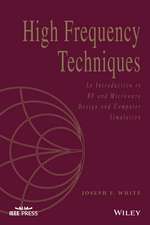Electromyography Signal Analysis and Characterization
Autor Sazzad Hussain, Mamun Bin Ibne Reazen Limba Engleză Paperback – 22 feb 2012
Preț: 390.05 lei
Nou
Puncte Express: 585
Preț estimativ în valută:
74.65€ • 77.11$ • 62.12£
74.65€ • 77.11$ • 62.12£
Carte tipărită la comandă
Livrare economică 26 martie-09 aprilie
Preluare comenzi: 021 569.72.76
Specificații
ISBN-13: 9783848412501
ISBN-10: 3848412500
Pagini: 132
Dimensiuni: 152 x 229 x 8 mm
Greutate: 0.2 kg
Editura: LAP LAMBERT ACADEMIC PUBLISHING AG & CO KG
Colecția LAP Lambert Academic Publishing
ISBN-10: 3848412500
Pagini: 132
Dimensiuni: 152 x 229 x 8 mm
Greutate: 0.2 kg
Editura: LAP LAMBERT ACADEMIC PUBLISHING AG & CO KG
Colecția LAP Lambert Academic Publishing
Notă biografică
Sazzad Hussain was born in Bangladesh, in November 1983. He is a Ph.D. candidate with the Learning and Affect Technologies Engineering (LATTE) Research Group at the University of Sydney, Australia. His research focus is on Multimodal Affect & Cognitive Load Detection, Machine Learning, Information Fusion and Physiological Information Processing.














